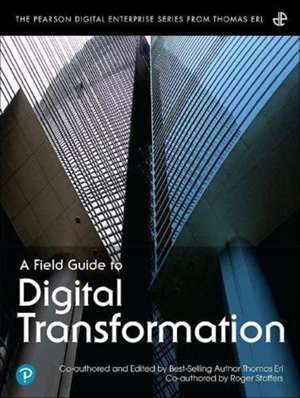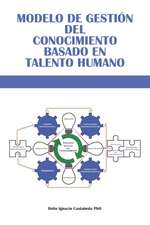Field Guide to Digital Transformation, A: The Pearson Digital Enterprise Series from Thomas Erl
Autor Roger Stoffers, Thomas Erlen Limba Engleză Paperback – 12 ian 2022
- Discover what digital transformation is, why it emerged and when to apply it
- Identify the significant business benefits that successful digital transformations can deliver and how to turn your organization into a "disruptive" force
- Prepare for and overcome the common challenges associated with digital transformation initiatives
- Understand the data-driven nature of digital transformation solutions and how they use and continually accumulate data intelligence
- Understand how digital transformation solutions can utilize AI technology for intelligent automated decision-making
- Gain insight into customer-centricity and how its practices are applied as part of digital transformations
- Explore key digital transformation automation technologies, such as Robotic Process Automation (RPA), Internet of Things (IoT), Blockchain. and Cloud Computing
- Explore key digital transformation data science technologies, such as Artificial Intelligence (AI), Machine Learning, and Big Data Analysis & Analytics
Preț: 170.82 lei
Preț vechi: 208.32 lei
-18% Nou
Puncte Express: 256
Preț estimativ în valută:
32.69€ • 34.49$ • 27.24£
32.69€ • 34.49$ • 27.24£
Carte disponibilă
Livrare economică 12-26 decembrie
Livrare express 27 noiembrie-03 decembrie pentru 29.43 lei
Preluare comenzi: 021 569.72.76
Specificații
ISBN-13: 9780137571840
ISBN-10: 0137571844
Pagini: 288
Dimensiuni: 176 x 231 x 15 mm
Greutate: 0.54 kg
Editura: Pearson Education (US)
Seria The Pearson Digital Enterprise Series from Thomas Erl
ISBN-10: 0137571844
Pagini: 288
Dimensiuni: 176 x 231 x 15 mm
Greutate: 0.54 kg
Editura: Pearson Education (US)
Seria The Pearson Digital Enterprise Series from Thomas Erl
Notă biografică
Thomas Erl is a best-selling IT author who has authored and co-authored 15 books published by Prentice Hall and Pearson Education and dedicated to topics focused on contemporary information technology and practices. These titles were delivered for the Pearson Digital Enterprise Series from Thomas Erl (formerly the Prentice Hall Service Technology Series from Thomas Erl) for which Thomas also acts as series editor.
As founder and president of Arcitura Education (www.arcitura.com), Thomas also leads the development of curricula for internationally recognized, vendor-neutral training and accreditation programs. Arcituras portfolio currently consists of over 100 courses, over 90 Pearson VUE exams, and over 40 certification tracks, covering topics such as Digital Transformation, Robotic Process Automation (RPA), DevOps, Blockchain, IoT, Containerization, Machine Learning, Artificial Intelligence (AI), Cybersecurity, Service-Oriented Architecture (SOA), Cloud Computing and Big Data Analytics.
Roger Stoffers is a TOGAF-certified Enterprise Architect passionate about Digital Transformation and Integration. Roger has worked for (and with) organizations in Telecommunication, Government and Finance industries, building 25 years of experience in multinational organizations. He has served as principal and lead Enterprise Domain Architect for digital business transformation initiatives, with strong focus for customer relationships and sustainable organizational agility in distributed environments.
Presently Roger works as Enterprise Architect for de Volksbank, fostering Customer Centricity and the organizations Sustainability & Social Responsibility goals with Data-Driven Customer Engagement and Decisioning. Independently, Roger is a worldwide consulting architect for digital transformation and integration, and a senior trainer for (enterprise) architecture topics and contemporary vendor-neutral technology and next-generation IT topics. He is a speaker at conferences about Digital Transformation, SOA and Microservices and Enterprise Architecture. He is a contributor for the Service-Oriented Architecture: Analysis and Design for Service and Microservices book from the Pearson Digital Enterprise Series from Thomas Erl.
As founder and president of Arcitura Education (www.arcitura.com), Thomas also leads the development of curricula for internationally recognized, vendor-neutral training and accreditation programs. Arcituras portfolio currently consists of over 100 courses, over 90 Pearson VUE exams, and over 40 certification tracks, covering topics such as Digital Transformation, Robotic Process Automation (RPA), DevOps, Blockchain, IoT, Containerization, Machine Learning, Artificial Intelligence (AI), Cybersecurity, Service-Oriented Architecture (SOA), Cloud Computing and Big Data Analytics.
Roger Stoffers is a TOGAF-certified Enterprise Architect passionate about Digital Transformation and Integration. Roger has worked for (and with) organizations in Telecommunication, Government and Finance industries, building 25 years of experience in multinational organizations. He has served as principal and lead Enterprise Domain Architect for digital business transformation initiatives, with strong focus for customer relationships and sustainable organizational agility in distributed environments.
Presently Roger works as Enterprise Architect for de Volksbank, fostering Customer Centricity and the organizations Sustainability & Social Responsibility goals with Data-Driven Customer Engagement and Decisioning. Independently, Roger is a worldwide consulting architect for digital transformation and integration, and a senior trainer for (enterprise) architecture topics and contemporary vendor-neutral technology and next-generation IT topics. He is a speaker at conferences about Digital Transformation, SOA and Microservices and Enterprise Architecture. He is a contributor for the Service-Oriented Architecture: Analysis and Design for Service and Microservices book from the Pearson Digital Enterprise Series from Thomas Erl.
Cuprins
About This Book xxvii
PART I: DIGITAL TRANSFORMATION FUNDAMENTALS
Chapter 1: Understanding Digital Transformation 3
(What is Digital Transformation?) 3
Business, Technology, Data and People 5
Digital Transformation and Business 6
Digital Transformation and Technology 7
Digital Transformation and Data 9
Digital Transformation and People 10
Digital Transformation and Organizations and Solutions 11
Chapter 2: Common Business Drivers 13
(What Led to Digital Transformation?) 13
Losing Touch with Customer Communities 14
Inability to Grow in Stale Marketplaces 16
Inability to Adapt to Rapidly Changing Marketplaces 16
Cold Customer Relationships 19
Inefficient Operations 19
Inefficient Decision-Making 21
Chapter 3: Common Technology Drivers 23
(What Enables Digital Transformation?) 23
Enhanced and Diverse Data Collection 25
Contemporary Data Science 27
Sophisticated Automation Technology 29
Autonomous Decision-Making 29
Centralized, Scalable, Resilient IT Resources 31
Immutable Data Storage 33
Ubiquitous Multiexperience Access 34
Chapter 4: Common Benefits and Goals 37
(Why Undergo a Digital Transformation?) 37
Enhanced Business Alignment 39
Enhanced Automation and Productivity 42
Enhanced Data Intelligence and Decision-Making 44
Improved Customer Experience and Customer Confidence 44
Improved Organizational Agility 48
Improved Ability to Attain Market Growth 50
Chapter 5: Common Risks and Challenges 53
(What Are the Pitfalls?) 53
Poor Data Quality and Data Bias 55
Increased Quantity of Vulnerable Digital Data 55
Resistance to Digital Culture 58
Risk of Over-Automation 59
Difficult to Govern 61
Chapter 6: Realizing Customer-Centricity 63
What Is a Product? 64
What Is a Customer? 65
Product-Centric vs. Customer-Centric Relationships 67
Transaction-Value vs. Relationship-Value Actions 69
Customer-Facing vs. Customer-Oriented Actions 71
Relationship Value and Warmth 71
Warmth in Communication 71
Warmth in Proactive Accommodation 74
Warmth in Customer Rewards 76
Warmth in Exceeding Customer Expectations 76
Single vs. Multi vs. Omni-Channel Customer Interactions 77
Customer Journeys 81
Customer Data Intelligence 84
Chapter 7: Data Intelligence Basics 89
Data Origins (Where Does the Data Come From?) 90
Corporate Data 92
Third-Party Data 92
Creating New Corporate Data Intelligence 92
Common Data Sources (Who Produces the Data?) 93
Operations Data 95
Customer Data 95
Social Media Data 95
Public Sector Data 96
Private Sector Data 97
Data Collection Methods (How Is the Data Collected?) 97
Manual Data Entry 98
Automated Data Entry or Collection 98
Telemetry Data Capture 98
Digitization 99
Data Ingress 101
Data Utilization Types (How Is the Data Used?) 101
Analysis and Reporting 101
Automated Decision-Making 102
Solution Input 103
Bot-Driven Automation 103
Model Training and Retraining 103
Historical Record Keeping 104
Chapter 8: Intelligent Decision-Making 105
Manual Decision-Making 107
Computer-Assisted Manual Decision-Making 107
Conditional Automated Decision-Making 108
Intelligent Manual Decision-Making 109
Intelligent Automated Decision-Making 112
Direct-Driven Automated Decision-Making 113
Periodic Automated Decision-Making 114
Realtime Automated Decision-Making 115
Intelligent Manual vs. Intelligent Automated Decision-Making 115
PART II: DIGITAL TRANSFORMATION IN PRACTICE
Chapter 9: Understanding Digital Transformation Solutions 121
Distributed Solution Design Basics 122
Data Ingress Basics 127
File Pull 127
File Push 128
API Pull 129
API Push 129
Data Streaming 130
Common Digital Transformation Technologies 132
Chapter 10: An Introduction to Digital Transformation Automation Technologies 135
Cloud Computing 137
Cloud Computing in Practice 138
Common Risks and Challenges 143
Blockchain 144
Blockchain in Practice 145
Partial Business Data Capture 147
Full Business Data Capture 148
Log Data Access Capture 150
Partial Business Data Store 151
Ledger Export 152
Common Risks and Challenges 153
Internet of Things (IoT) 154
IoT Devices 154
IoT in Practice 160
Common Risks and Challenges 163
Robotic Process Automation (RPA) 164
RPA in Practice 165
Common Risks and Challenges 168
Chapter 11: An Introduction to Digital Transformation Data Science Technologies 171
Big Data Analysis and Analytics 172
The Five V's of Big Data 175
Big Data in Practice 177
Common Risks and Challenges 178
Machine Learning 179
Model Training 180
Machine Learning in Practice 180
Common Risks and Challenges 184
Artificial Intelligence (AI) 186
Neural Networks 186
Automated Decision-Making 187
AI in Practice 189
Common Risks and Challenges 189
Chapter 12: Inside a Customer-Centric Solution 193
Scenario Background 195
Business Challenges 195
The Original Customer Journey 196
Business Objectives 201
Terminology Recap 201
Key Terms from Chapter 6: Realizing Customer-Centricity 202
Key Terms from Chapter 7: Data Intelligence Basics 202
Key Terms from Chapter 8: Intelligent Decision-Making 203
Key Terms from Chapter 9: Understanding Digital Transformation Solutions 203
Key Terms from Chapter 10: An Introduction to Digital Transformation Automation Technologies 204
Key Terms from Chapter 11: An Introduction to Digital Transformation Data Science Technologies 204
The Enhanced Customer Journey 204
Supporting Data Sources 205
Step-by-Step Business Process 206
Future Decision-Making 241
About the Authors 243
Index 245











